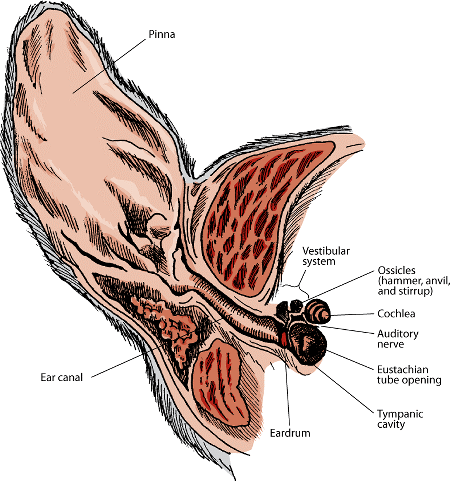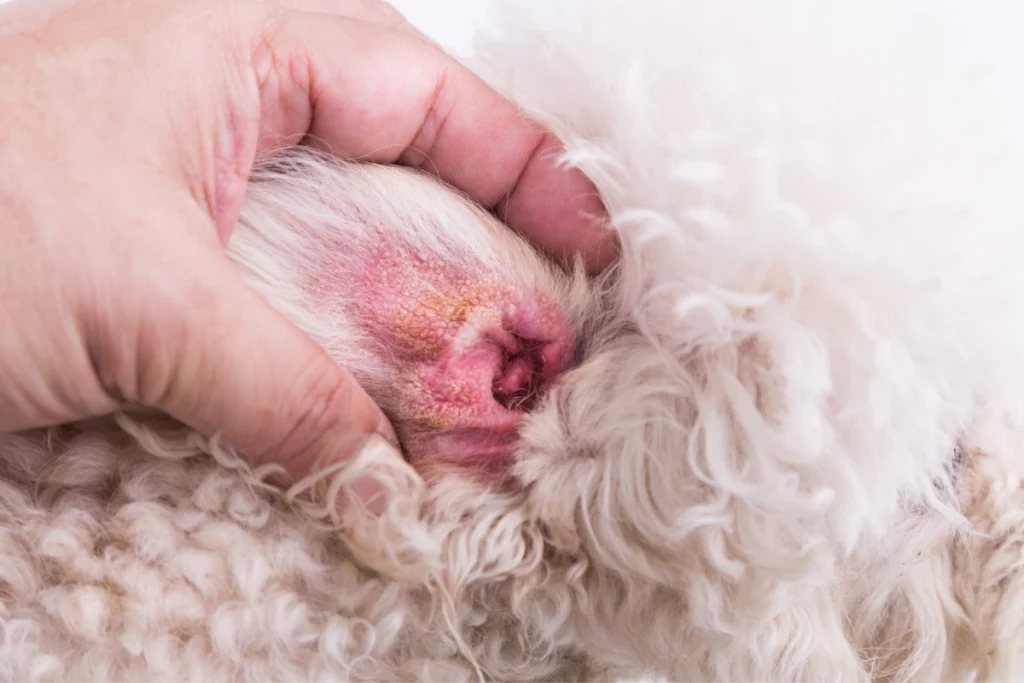Can you name one distinct feature of the Poodle?

I can name several! One cool feature that is often skipped when describing a Poodle is its ears. Yes, their ears! Their magnificent ears add to the charm of the Poodle and are something that needs to be regularly maintained.
What Will You Learn? 👇
Why do their ears need to be maintained?
The reason you have to pay a lot of attention to your Poodle’s ears when cleaning their face is that they have a soft curly coat which means hairs around them can easily trap dirt, bacteria, fungus, sweat, and more, putting them at risk of infections. Alongside this, hairs can grow inside of their ears, making them difficult to maintain. Moreover, hairy ears for a Poodle means that it can stop sufficient air circulation from happening, putting them at risk of acute illnesses.

Read our Smart Poodles - Smart Tricks eBook for only $2.99
Dive into a treasure trove of engaging tricks and tips designed specifically for your poodle!

Common Poodle ear health issues
Before you get a Poodle or if you have one, it’s important to be aware of the potential symptoms of an infection they might face. Having this foundation of knowledge will motivate you to clean them more and stay on top of their health. While there can be a risk of different infections, normally, a Poodle is often diagnosed with one of the following infections:
- Otitis Externa: When their ear canal is inflamed
- Otitis Media: When their middle ear is inflamed
- Otitis Interna: When their inner ear is inflamed
Out of these three types of ear infections, the most common one a Poodle is subject to is Otitis Externa a.k.a. a yeast infection.

Yeast ear infections
Sometimes a Poodle can get a yeast infection in one or both ears. If there’s a yeast infection in both ears, it’s also likely that it may be somewhere else, like on their paws. The reason they can get a yeast infection is that there is a yeast that naturally occurs in their body in small amounts.
Yeast infections are usually caused by underlying allergies and poor ventilation within the ear canal (due to its natural shape and fur within the canal). Oftentimes, an infection occurs after a dog gets wet when swimming or at the groomer.
| Allergen | Description | Symptoms | Treatment |
|---|---|---|---|
| Food | Ingredients in their diet, such as chicken, beef, dairy, and grains | Itching, scratching, paw licking, ear infections, skin irritation and redness | Elimination diet, hypoallergenic diet, antifungal medications, probiotics |
| Environmental | Pollen, dust mites, mold spores, and flea bites | Itching, scratching, paw licking, ear infections, skin irritation and redness | Allergy shots, antifungal medications, hypoallergenic bedding and cleaning products |
| Contact | Chemicals in grooming products, fabrics, or other materials | Itching, redness, swelling, and sores | Avoidance of the allergen, antifungal medications, topical creams and ointments |
| Seasonal | Seasonal changes in pollen or grasses | Itching, scratching, paw licking, ear infections, skin irritation and redness | Allergy shots, antifungal medications, hypoallergenic bedding and cleaning products |
It’s important to note that while these allergens are common, they may not be the sole cause of yeast infections in Poodles. Consultation with a veterinarian is recommended for proper diagnosis and treatment.
Ear mites
While Poodles of any age can get ear mites, they’re most common in puppies. Mites are contagious small arachnids that can spread easily from dogs and other animals. Ear infections resulting from mites can be dangerous if not treated, as the mites can lay eggs in their ears, causing more to grow.
| Type of Ear Infection | Causes | Symptoms | Treatments |
|---|---|---|---|
| Otitis externa (Swimmer’s ear) | Bacterial or fungal infection | Ear pain, itching, discharge, swelling, redness | Antibiotic or antifungal eardrops, pain relievers |
| Acute otitis media (AOM) | Bacterial infection | Ear pain, fever, hearing loss, headache, fluid buildup behind eardrum | Antibiotics, pain relievers, observation for mild cases |
| Chronic otitis media (COM) | Persistent or recurring AOM, eardrum perforation | Fluid discharge from ear, hearing loss, tinnitus, vertigo | Antibiotics, ear cleaning, surgery for severe cases |
| Mastoiditis | Untreated AOM, infection spreading to mastoid bone | Ear pain, fever, headache, hearing loss, redness and swelling behind ear | Antibiotics, surgery in severe cases |
| Serous otitis media (SOM) | Eustachian tube dysfunction, allergies, sinus infections | Muffled hearing, feeling of fullness in ear, tinnitus | Observation, treatment of underlying cause, surgery in severe cases |
Symptoms of ear infections
Usually, symptoms tend to remain the same when it comes to the three types of ear infections. Such symptoms are:
- Odor: This is one of the very first symptoms a dog owner notices when a Poodle has an ear infection. Sometimes odors can be very powerful and too strong, causing you to turn your head. If you find your Poodle’s ear has a smell, you should immediately check further, as a healthy ear will not have an odor.
- Rubbing: If your Poodle’s ears are infected, they will become very itchy, and they will try their best to ease it by scratching or rubbing. Common signs to look out for is a Poodle rubbing its head against the wall, floor, and other surfaces.
- Discharge: If you find an unusual build up of wax in their ear that has a black, green, or different color, it’s a sign of infection. The texture of the wax could be thick or runny, making it unpleasant for your dog. In addition to this, if pus or their ears are bleeding, that is also a major sign of infection that needs to be addressed immediately.
- Dizziness: A severe ear infection will cause a Poodle to loose their balance and might become dizzy.
- Head shaking: Sometimes, a Poodle might rapidly shake their head to try and stop the pain.
- Unusual back and forth eye movement: This symptom most commonly occurs in Otitis Media infections. If you notice this, you should seek professional help from a vet immediately.
- Reduced appetite: Depending on how severe the infection is, a Poodle might have a reduced appetite and a fever alongside it.
Tests that can be run to determine the cause
If you suspect your Poodle has an ear infection, you will want to take them to a vet for treatment. Usually, a vet will perform tests to diagnose the ear infection and then prescribe a suitable treatment.
The tests a vet might conduct are:
- Cytology test: This is a special ear swab taken of the ear, used to detect the type of bacteria or yeast present, and to establish how advanced the infection is. Generally, they will look at the sample under the microscope to define the type of bacteria and infection.
- Culture/sensitivity tests: This involves a medium/broth which grows the bacteria to help identify the type of infection. Antibiotics are also used to check the resistance and see how effective they are in removing the infection.
- Blood tests: Sometimes, a Poodle might have an ear infection as a result of an underlying condition. A vet might take blood samples to check if a Poodle has an endocrine disease.
- Skull x-rays, CT scan, or MRI: If the infection is more serious, they might take further scans to see how serious the inner ear infection is.
- Ear flush: A vet may conduct a full ear flush to examine the whole ear canal. A flush is done to examine the canal deeply and to remove any debris, as well as to instill medicine.
Treatments
If cleaning does not work, a vet will normally prescribe the following treatments:
- Oral: Usually, a vet might give your dog a course of antibiotics over 3-7 days for the infection to clear up. Oral medicine is quite ineffective and does not penetrate the ear canal well. It may be used in those dogs who are in too much pain for drops to be used, at least initially. In this case, they might also be prescribed antifungal or steroid medication as opposed to antibiotics.
- Topical: Sometimes, they might prescribe a cleanser, ointment, or eardrop to remove an infection. This medication is applied deep in their ear canal and is slowly released into their ear.
- Surgical: In the worst circumstances and rare cases, chronic ear infections may require surgery called ablation. Surgery is performed to stop their inner ears from scarring, and their whole ear canal is removed. This type of surgery is the last option and is only conducted if other treatments are ineffective.
How to Prevent an Ear Infection on Your Poodle
As a dog owner, you can play your part to stop ear infections from occurring. To do this, you have to routinely clean their ears every 1 to 2 weeks, for those prone to infections or wax buildup. A dog with healthy ears would not need ear cleaning, and it can do more harm than good.
It’s important not to use alcohol or hydrogen peroxide and not to put cotton swabs in their ears as it could perforate their eardrum.
How to properly care for your poodle ears
There’s not a lot to proper ear maintenance; in fact, it’s quite easy to keep on top of once you get the hang of it. However, you might find that there’s some debate in the dog community if they need their ears plucked, shaved, or cleaned in general. Today we’re going to look at all three.
Do poodles need their ears plucked?
In all three types of Poodles, hair can grow in and out of their ears. For this reason, it’s perfectly ok for their ears to be plucked as a part of their grooming routine. If you plan on plucking your Poodle’s ears, make sure you do it at a time they’re tired out, i.e., after being fed or exercised.
Vets usually only advise ear plucking if the dog is experiencing ear infections. When the ear is healthy, plucking is not needed and can cause unnecessary pain and inflammation.
Once you’re ready, gently bend the Poodle’s ear back and place a bit of powder in the ears. Use a hemostat to help pluck and grip their hairs carefully. To make the experience as painless as possible for your Poodle, you will want to pull quickly. Make sure you only pull hairs that are visible to the human eye.
How to clean poodle ears
To clean a Poodle’s ears, you should buy a dog-friendly ear cleaning solution that contains little chemicals. Ideally, you should get one with a dropper you can easily dispense into their ears. When cleaning their ears, you should use a cotton ball and massage their ear base for 30 seconds-1minute.
It’s essential to use a cotton ball as it will serve as a stopper for the wax and allow liquid to flow into their canal. If you notice your Poodle has wax, keep repeating this process with cotton balls until it becomes clear. Once done, clean around the inside of the ear and their flap with a new cotton ball, but do not use a cue tip.
How to shave poodle ears
In addition to plucking, you can also opt to have your Poodle’s ears shaved. If you shave their ears, you will want to use short trimming shears to cut their hair. Small clippers are effective as they can reach inside their ear and keep their hair short. On the contrary, if you don’t feel confident, you can always take your Poodle to a vet to have this done professionally.
Conclusion
Overall, grooming a Poodle’s ears is something that should not be skipped and done every 1-2 weeks with an ear cleaning solution. If you don’t look after them, they could have bacteria, skin infections, and moisture build-up.
To reduce the risk of this, you can try plucking or shaving the hair around their ears. Look out for bad odors, itching, redness, colored ear wax, and a Poodle rubbing its head as it could be a sign of a potential ear infection.
Have you noticed an ear infection in your dog? Share your experience in the comments down below.
Marko is the founder and author at PoodleHQ, where he blends profound expertise with formal training in Animal Behavior and Canine Genetics. With multiple generations of poodles under his care, he’s a breed connoisseur, honored with the Canine Care Excellence Award and lauded by the International Pet Enthusiasts Association.


Thank you, this article has been very helpful.
I’m glad you liked it, and even more if it helped your poodle 🙂